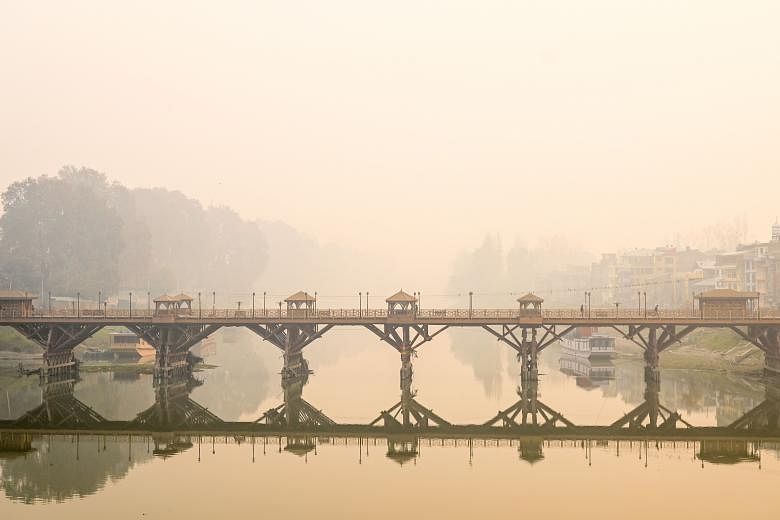SRINAGAR, INDIA (REUTERS) - A flood management plan, drawn up to protect the capital of Indian-administered Kashmir after record rainfall in 2014 caused widespread damage and about 150 deaths, is drying out an internationally protected wetland near Srinagar, officials say.
The two-stage plan, started in 2018, includes dredging and deepening an existing drainage channel that diverts water from the River Jhelum around the city, through the Hokera wetland and back into the river in Baramullah district to prevent flooding.
The flood spill channel in Hokera has now been excavated down to an average of 4.6m in the first phase of the plan, and is expected to help ward off minor flood threats.
But the work has also dried out about half of the 1,375ha internationally recognised wetland, as more water runs off into the channel, putting wildlife and nature at risk, according to wetland wildlife warden Ifshan Dewan.
Six smaller channels dug in an unsuccessful bid to rewet the land have ended up draining it further, with nearly all of Hokera now appearing dry, the Thomson Reuters Foundation witnessed on a visit this month.
Assistant Professor Sami Ullah Bhat from the University of Kashmir School of Earth and Environmental Sciences, noted that thousands of farmers rely on the wetland as a source of fodder for the cattle they rear to produce milk and beef.
"Damage to the wetland will have a direct impact on their livelihoods," he said.
Villagers said there had been far less grass as the wetland - known locally as Hokersar - dried out over the past two years, forcing them to buy fodder for their cows during winter.
"If Hokersar stays this way, we would have to work as daily labourers for our livelihood," said Mr Ghulam Ahmad of Lawaypora village, who has three cows.
A letter sent by the office of Kashmir's regional wildlife warden to the Irrigation and Flood Control (IFC) Department this month said the work had caused "water deficiency of the wetland and converted a major portion of the wetland into a land mass".
An earlier letter this month, also from the wildlife warden's office, demanded the IFC make changes to protect the wetland "on a war-footing basis without further delay".
Mr Sharachchandra Lele, an environmental policy and governance fellow at the Bangalore-based Ashoka Trust for Research in Ecology and the Environment, said officials should have been aware the project was likely to damage the wetland.
"Wetlands by definition are shallow water bodies retaining some water level all year around. Any attempt to dredge a wetland is bound to destroy its basic ecological structure and function," he told the Thomson Reuters Foundation.
Ramsar concern
Because the wetland is an internationally recognised Ramsar conservation site, the government plan to expand a flood channel passing through it should have raised a red flag, he said.
The Hokera wetland sits along a migratory route used by nearly 70 species of water birds, from egrets and cormorants to ducks, according to the Ramsar Sites Information Service.
Ms Reiko Iitsuka, a senior adviser for Asia-Oceania at the Ramsar secretariat, said her office had contacted the Indian government, seeking more information on the Hokera situation.
The Thomson Reuters Foundation has seen more than a dozen letters sent by Kashmir wildlife officials since July 2019 asking the IFC and its dredging contractor to take action to ensure the wetland can continue to hold water, as stipulated in the original contract for the work.
That includes installing sluice gates to maintain water levels, and removing dredged material dumped in the wetland.
Wildlife officials said the measures were designed to ensure the wetland has 0.9-1.2m of water year-round.
The IFC's chief engineer, Mr Iftikhar Kakroo, said he had recently seen for himself how the wetland was drying out. "But we will hopefully find a solution to this soon," he told the Thomson Reuters Foundation.
The agency executing the work informed him they were removing the excavated material from the wetland, he noted.
"The (sluice) gates will also be installed. It has not been done so far because the design was not ready," he added.
Consultations are under way with the government on the second phase of the flood management project, which is expected to start soon and will increase the carrying capacity of the River Jhelum and its flood spill channel further, he added.
Bats, not boats
At the wetland, which lies 12km west of Srinagar city centre, people now walk across land where previously boats were needed to navigate the water. Animals graze and boys play cricket amid mounds of dumped material.
Warden Dewan said 80 per cent of the dredged material was still lying in the wetland.
"Hokersar is gone," said student Touseef Lone, 22, who lives in Zainakote, a town adjacent to the wetland.
"My legs tremble when I see myself walking deep inside the wetland, which only accepted boats two years back," he said, as he strolled through a dry patch of the once-wet land. "Look at these wide cracks. This is what they have done to Hokersar by draining all its water," he said.

